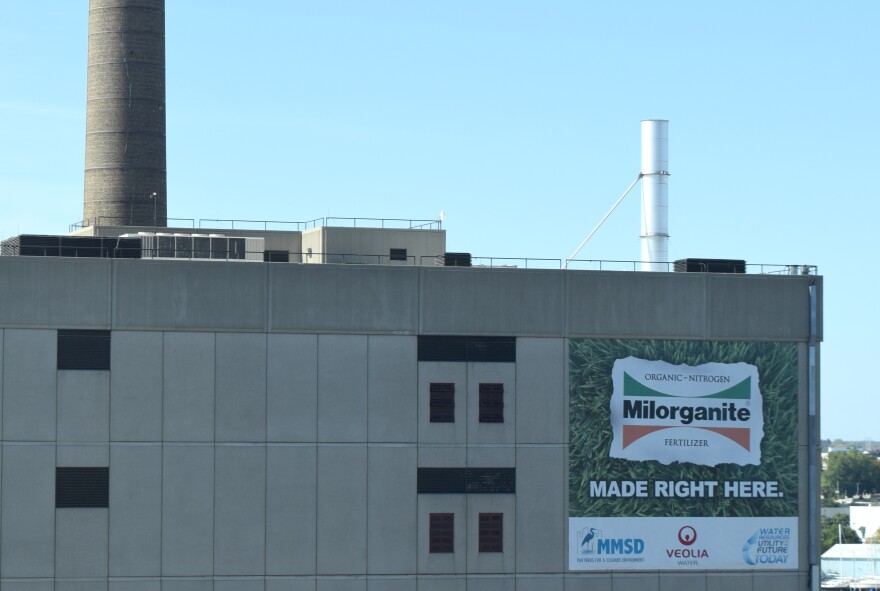Imagine you're driving into downtown Milwaukee over the Hoan Bridge. Lake Michigan glistens to the east, the city's skyline rises before you, and then WHAM! A smell infiltrates your car and overwhelms your senses.
If you've experienced it, you know what we are referring to. If you haven't, some people describe the smell like this:

Bubbler Talk question asker Terry wanted us to follow that scent: "What's that rotten egg smell, driving over the Hoan Bridge?"

“It’s a tough call where exactly it’s coming from," says Bill Graffin, Public Information Manager for the Milwaukee Metropolitan Sewage District, "but when you’re driving over the bridge over the waste water treatment plant – it’s probably a good guess that it’s coming from here."
Graffin is referring to the Jones Island Water Reclamation Facility. It has been home to MMSD’s wastewater treatment facility since 1926. In other words, it’s where your sewage goes when you flush the toilet, run your garbage disposal, or spit toothpaste down the drain.
However, it turns out that the crap you smell is actually doing a lot of good.
“We treat waste water here and we also have a distinctive smell that comes from the production of Milorganite, which is a fertilizer that we’ve been making since 1926 and selling around the country,” explains Graffin.
Milorganite stands for "Milwaukee Organic Nitrogen." This organic fertilizer is made with that waste water you smell through four steps.

1. The screening process takes out all large objects from the untreated water.
2. The water is sent to one of eight settling tanks on Jones Island.
Each settling tank holds 1.8 million gallons of liquid where oil and grease float to the top and solids sink to the bottom.
3. A secondary treatment employs 'the good bugs' to clean the water.

“Those organisms or bugs eat organic material out of the water, they clean the water – they’re the work horses of waste water treatment," says Graffin. "We take a certain percentage of those bugs out of the mix every day and reintroduce the rest back into the tanks to clean the water. And we take those bugs and we put them into this big huge building – the Milorganite factory – and we squeeze the water out of them, put them into these huge dryers and tumble them into certain pellet sizes and then they’re sold as fertilizer around the country.”

The building with the Milorganite banner on the West side of the Hoan Bridge is where the dryers tumble dead microbes at temperatures up to 1200 degrees. The steam you see coming out of the large tower is letting out waste heat.
“We have a landfill in Muskego that we get gas from that goes into these turbines," notes Graffin. "We take some of that waste heat from the turbines and we put it into the dryers for Milorganite and then the excess goes up that stack and out.”

4. What water is left from the treatment process is disinfected with a chlorine byproduct that is then neutralized before it is returned to Lake Michigan.
"The water that goes out of the plant is much, much cleaner than what comes in. And we have a pretty good track record for meeting treatment standards that are above and beyond what the state and federal government call for,” notes Graffin.
In fact, since the deep tunnel system came online in 1994, MMSD has captured and cleaned 98.4% of every drop of water that's gotten into the regional sewer system - a total of 1,669.7 billion gallons of water.
READ: What Happened to Milwaukee's Signature Yeast Smell?
There are many factors that can impact what you smell on your drive over the Hoan Bridge. Graffin says that although this year didn't present as big of a problem, the cladophora algae that washes up on the shore of Lake Michigan produces a smell very similar to sewage when baked in the sun. So whether it's algae, wind direction, or even the time of year - sometimes unpleasant smells are just a part of living in Milwaukee.

“Well there’s no question that it is a beneficial re-use, but if it’s an odor to someone, it’s an odor. You can’t explain your way out of that one," Graffin jokes. "If people don’t like it...I don’t know what to say except we’re looking at it, we’re trying to come up with some solutions here.”
Graffin notes that some of the proposed solutions such as covers for the settling tanks would cost millions of tax payer dollars. "We're on an island with industrial processes...so there are a lot of other things going on (that can cause an odor). We want to make sure we're fixing the right thing before we spend any of that money," he says.
If you are skeptical about using bio solids such as Milorganite in your garden or on your lawn, Graffin says that its 91 year history (and counting) speaks for its quality. It even starred in the classic comedy, Caddyshack! See if you can spot it in this scene:
“People love Milorganite," says Graffin. "Golf course superintendents, the master gardeners, people who really know their stuff know it’s a great product. It’s a slow release fertilizer that is just fantastic. You know, we call it ‘goof proof’ because you really can’t screw it up.”
If the smell does truly bother you, you can always plug your nose as you drive over the bridge - just remember to keep the other hand on the steering wheel.

Editor's note: This piece was originally published on Nov. 3, 2017.
Have a question you'd like WUWM to answer? Submit your query below.
_














